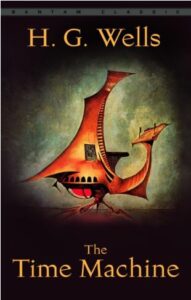The Time Machine By H G Wells
“The Time Machine” by H.G. Wells is a seminal work in science fiction, originally published in 1895. It has had a profound influence on the genre and has been the source of numerous adaptations and reinterpretations. The novel explores themes of time travel, societal evolution, and the implications of scientific discovery.
Summary
The novel’s protagonist, known simply as the Time Traveller, invents a machine that allows him to travel through time. He embarks on a journey into the distant future, eventually arriving in the year 802,701 A.D. There, he encounters two distinct races: the Eloi, a gentle and childlike people living above ground, and the Morlocks, a subterranean and sinister species. The Time Traveller becomes entangled in the complex dynamics of this future world and must navigate the mysteries and dangers it presents.
Critical Analysis
H.G. Wells’ “The Time Machine” is a groundbreaking work of science fiction that laid the foundation for the exploration of time travel in the genre. It’s notable for its imaginative depiction of a distant future where humanity has evolved into distinct, contrasting species. The novel blends scientific and speculative elements, allowing readers to contemplate the implications of time travel and societal evolution.
One key aspect of the novel is its commentary on class struggle. The division between the Eloi, representing the leisure class, and the Morlocks, symbolizing the laboring class, reflects Wells’ concerns about the socio-economic disparities of his own time. The Time Traveller’s observations of this future world serve as a critique of class-based societies.
Themes
1. Time and Progress: “The Time Machine” is inherently concerned with the concept of time and the progression of humanity. Wells explores how society might evolve over vast periods, raising questions about the ultimate fate of the human race.
2. Social Inequality: The novel delves into the theme of social inequality by presenting two distinct classes—the privileged but fragile Eloi and the industrious but predatory Morlocks. It underscores the dangers of extreme class divisions.
3. Technological Hubris: The Time Traveller’s invention is a symbol of human curiosity and scientific progress. However, the story also suggests that unchecked technological advancement can have unintended and detrimental consequences, leading to the decline of civilization.
4. Evolution and Regression: The novel raises questions about the nature of societal evolution and the possibility of regression. It challenges readers to consider what factors might drive the advancement or degeneration of humanity.
“The Time Machine” is a thought-provoking and visionary work that continues to captivate readers with its exploration of time, class conflict, and the consequences of scientific discovery. H.G. Wells’ narrative skill and his ability to provoke contemplation about the future and human nature make this novel a classic of the science fiction genre.
Read More:

